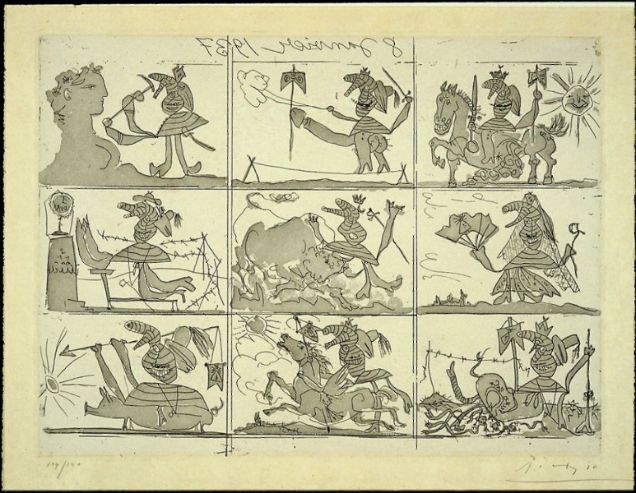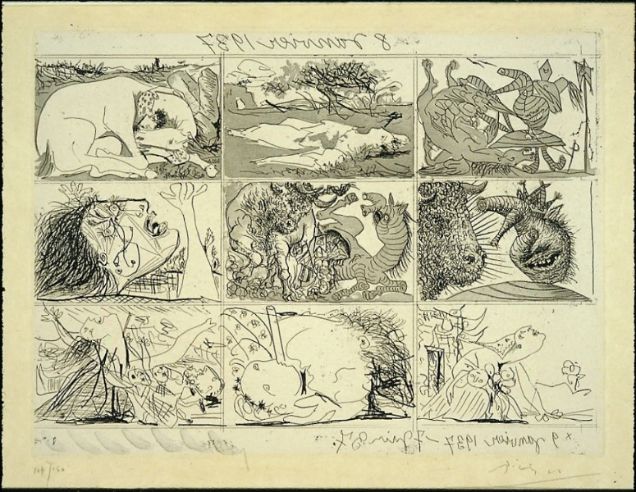|
||
|
Overview by Stone Riley
Picasso's famous two-page propaganda comic book (if I may call it that) seems to be a very complicated work of art indeed. It is nasty in the extreme and yet perhaps exactly right. But this bewildering and astonishing thing is currently too far past my ken for me to offer any more acute analysis than that. I will complement the quality of the work: One single picture (Picture #15, right end of the middle row of Sheet #2) catalyzed my vision of a major aspect of a major painting I was making. Picasso evidently got a tyrant's smile just right. However, I will not venture to say more. Instead, I have simply gathered a few informative and thought provoking materials from the web and I hope this will be useful to you.
Wikipedia article "The Dream and Lie of Franco"
A capsule description of the thing and its circumstances.
The Dream and Lie of Franco is a series of two sheets of prints, comprising individual 18 images, and an accompanying prose poem, by Pablo Picasso produced in 1937. The sheets each contain nine images arranged in a 3x3 grid. The first 14, in etching and aquatint, are dated 8 January 1937. The remaining 4 images were added to the second printing plate later, without use of aquatint, and dated June 7, 1937. The Dream and Lie of Franco is significant as Picasso's first overtly political work and prefigures his iconic political painting Guernica. The etchings satirise Spanish dictator Francisco Franco's claim to represent and defend conservative Spanish culture and values by showing him in various ridiculous guises destroying Spain and its culture while the poem denounces "evil-omened polyps". Three of the four images added in June 1937 are directly related to studies for Guernica. The individual images were originally intended to be published as postcards to raise funds for the Spanish Republican government, and sold at the Spanish Pavilion of the 1937 World's Fair, although it is unclear whether any prints were made or sold in postcard format.
"Essay On Style In Guernica" by Stone Riley
Related material of possible interest.
For me personally, the "Dream And Lie" was helpful in my study of Picasso's great mural "Guernica". My study of that great work was in preparation for a painting of my own called "Drone Strike In North Waziristan". The essay about "Guernica" that I'm offering here details some things I learned through that very practical study.
"A Look Inside Picasso's War Images" by Elizabeth Francesconi
A scholarly research paper taking a large deep look at the work and its circumstances.
Picasso said in 1944, after joining of the French Communist Party, "Painting is not meant for decorating apartments. It is an instrument of active and defensive war against the enemy." Many of Picasso's works throughout his life appear to abandon current events except in times of extreme turmoil. However, certain incidents that pertain to his Spanish heritage, like the Spanish Civil War, were more likely to be seen in his works at that time. In his later works, Picasso did not deliberately focus on creating a war subject; instead, the figures used in his propagandistic works escaped into his chosen medium as the memories of war faded into the past. Picasso is a native of Spain and even though he left to live in Paris in 1904, he never lost his ties to his heritage and the Spanish population. Picasso's "Dream and Lie of Franco" is a pair of prints of which the Meadows Museum Collection owns six working proofs. Picasso etched these plates as a response to the Spanish Civil War during the late 1930s. These images of Franco reflect Picasso's and other Spaniards' political views regarding the war. Though he was living in Paris at the time of the Civil War, Picasso was able to follow the current events through newspapers. The Dream and Lie of Franco was not the only political work to be completed during his life, however. By viewing this work and Picasso's other political works, such as Guernica, in the context of the political history of Spain, I will show that Picasso's Dream and Lie of Franco reflects the emotions of the Spanish people during the Spanish Civil War, along with a response that can be applied to new situations of political unrest as they are discovered in the future. It is important to explore the events of Franco and the Spanish Civil War before examining Picasso's Dream and Lie of Franco. In 1930, dictator General Primo de Rivera and his monarchy fell, forcing King Alfonso XIII into exile. The new Republic government that was created as a result promised to create a modern society for the farmers in Spain. The agricultural workers had only known of primitive agriculture techniques performed on poor land during the time of the monarchy.[5] In order to improve these work conditions, the government took the responsibility upon themselves to create a modern democratic society. Nevertheless, the conservative property owners viewed the new Republic government's act of giving land to those less fortunate as a personal attack. The Republic's attempt to pull religion out of secondary education was also seen by the conservatives as an attempt to remove Christianity from the entire country. [Much more follows on that website.]
"Picasso's Dream and Lie of Franco: poem and images" by Jerome Rothenberg
Here is an English translation by poet Jerome Rothenberg of the poem which Picasso published with the pictures.
owl fandango escabeche swords of octopus of evil omen furry dishrag scalps afoot in middle of the skillet bare balls popped into a cone of codfish sherbert fried in scabies of his oxen heart – mouth full of marmalade of bedbugs of his words – silver bells & cockle shells & guts braided in a row – a pinky in erection not a grape & not a fig – commedia del arte of bad weaving & smudged clouds – cosmetics of a garbage truck – the rape of las meninas cries & outcries – casket on shoulders crammed with sausages & mouths – rage that contorts the drawing of a shadow that lashes teeth nailed into sand the horse ripped open top to bottom in the sun which reads it for the flies who tack a rocket of white lilies to the knots spliced in the sardine heavy nets – lamp of lice where dog is & a knot of rats & hide outs in a palace of old rags – the banners frying in the skillet twist in black of ink sauce spilled in drops of blood that gun him down – the street soars to the clouds its feet bound to a sea of wax that makes its guts rot & the veil that covers it is singing dancing mad with sorrow – a flight of fishing poles alhigui and alhigui of the moving van first class interment – broken wings spinning in the spider web of dry bread & clear water a paella made of sugar & of velvet that paints a whiplash on its cheeks – the light blocked out the eyes before the mirror that make monkeyshines the chunk of nougat in the flames that gnaws itself the lips around the wound – cries of children cries of women cries of birds cries of flowers cries of wood & stone cries of bricks cries of furniture of beds of chairs of curtains of casseroles of cats & papers cries of smells that claw themselves of smoke that gnaws the neck of cries that boil in cauldron & the rain of birds that floods the sea that eats into the bone & breaks the teeth biting the cotton that the sun wipes on its plate that bourse & bank hide in the footprint left imbedded in the rock.
|

